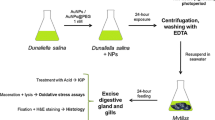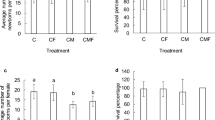Abstract
Pharmaceuticals have been recognized as a new class of environmental pollutants in recent years. But data about their potential for transfer and biomagnification in aquatic food chains are still lacking. In this study, bioaccumulation of the macrolide antibiotic roxithromycin (ROX) was determined in an experimental aquatic food chain involving the green algae Scenedesmus obliquus, the water flea Daphnia magna and the crucian carp Carassius auratus. After 48 h of exposure, S. obliquus accumulated ROX from media, with bioconcentration factors (BCFs) of 74.6, 46.3, and 24.5 l kg−1 at nominal exposure concentrations of 4, 20, and 100 μg l−1, respectively. After 48 h of feeding ROX-contaminated algae, D. magna was able to accumulate ROX in all three concentration treatments, but biomagnification did not occur at this trophic level, as biomagnification factors (BMFs) varied from 0.21 to 0.29 in different concentration treatments were well below one. In tissues (muscle, gill, liver, and bile) of C. auratus fed with contaminated daphnia for 8 days, no biomagnification was observed. However, this species did accumulate a certain degree of ROX through food chain transfer, and the tissue burden was greatest in the liver > muscle > gill and lowest in the bile. This work suggests that the trophic transfer should be a matter of concern for ecological risk assessments of pharmaceutical substances in aquatic food webs.



Similar content being viewed by others
References
Akkanen J, Kukkonen JV (2003) Biotransformation and bioconcentration of pyrene in Daphnia magna. Aquat Toxicol 64:53–61
Barnes KK, Kolpin DW, Furlong ET, Zaugg SD, Meyer MT, Barber LB (2008) A national reconnaissance of pharmaceuticals and other organic wastewater contaminants in the United States—I) groundwater. Sci Total Environ 402:192–200
Bi YF, Miao SS, Lu YC, Qiu CB, Zhou Y, Yang H (2012) Phytotoxicity, bioaccumulation and degradation of isoproturon in green algae. J Hazard Mater 243:242–249
Boonsaner M, Hawker DW (2013) Evaluation of food chain transfer of the antibiotic oxytetracycline and human risk assessment. Chemosphere 93:1009–1014
Boxall ABA, Ericson JF (2012) Environmental fate of human pharmaceuticals. In: Brooks BW, Huggett DB (eds) Human pharmaceuticals in the environment: current and future perspectives, 4th edn. Springer, New York, pp 63–83
Brain RA, Hanson ML, Solomon KR, Brooks BW (2008) Aquatic plants exposed to pharmaceuticals: effects and risk. Rev Environ Contam Toxicol 192:67–115
Breuer G, Lamers PP, Martens DE, Draaisma RB, Wijffels RH (2012) The impact of nitrogen starvation on the dynamics of triacylglycerol accumulation in nine microalgae strains. Bioresour Technol 124:217–226
Brodin T, Fick J, Jonsson M, Klaminder J (2013) Dilute concentrations of a psychiatric drug alter behavior of fish from natural populations. Science 339:814–815
Brozinski JM, Lahti M, Meierjohann A, Oikari A, Kronberg L (2012) The anti-inflammatory drugs diclofenac, naproxen and ibuprofen are found in the bile of wild fish caught downstream of a wastewater treatment plant. Environ Sci Technol 47:342–348
Collado N, Rodriguez-Mozaz S, Gros M, Rubirola A, Barceló D, Comas J, Rodriguez-Roda I, Buttiglieri G (2014) Pharmaceuticals occurrence in a WWTP with significant industrial contribution and its input into the river system. Environ Pollut 185:202–212
Coogan MA, Edziyie RE, La Point TW, Venables BJ (2007) Algal bioaccumulation of triclocarban, triclosan, and methyl-triclosan in a North Texas wastewater treatment plant receiving stream. Chemosphere 67:1911–1918
Dietrich S, Ploessl F, Bracher F, Laforsch C (2010) Single and combined toxicity of pharmaceuticals at environmentally relevant concentrations in Daphnia magna–a multigenerational study. Chemosphere 79:60–66
Favari L, López E, Martı́nez-Tabche L, Dıaz-Pardo E (2002) Effect of insecticides on plankton and fish of Ignacio Ramirez reservoir (Mexico): a biochemical and biomagnification study. Ecotoxicol Environ Saf 51:177–186
Gomes RL, Deacon HE, Lai KM, Birkett JW, Scrimshaw MD, Lester JN (2004) An assessment of the bioaccumulation of estrone in Daphnia magna. Environ Toxicol Chem 23:105–108
Jin ZP, Luo K, Zhang S, Zheng Q, Yang H (2012) Bioaccumulation and catabolism of prometryne in green algae. Chemosphere 87:278–284
Kainz M, Arts MT, Mazumder A (2008) Essential versus potentially toxic dietary substances: a seasonal comparison of essential fatty acids and methyl mercury concentrations in the planktonic food web. Environ Pollut 155:262–270
Kim HY, Jeon J, Hollender J, Yu S, Kim SD (2014) Aqueous and dietary bioaccumulation of antibiotic tetracycline in D. magna and its multigenerational transfer. J Hazard Mater 279:428–435
Ko FC, Baker JE, Tew KS (2012) Kinetics of polychlorinated biphenyl partitioning to marine Chrysophyte Isochrysis galbana. Sci Total Environ 416:410–417
Koelmans AA (2014) Limited reversibility of bioconcentration of hydrophobic organic chemicals in phytoplankton. Environ Sci Technol 48:7341–7348
Kosma CI, Lambropoulou DA, Albanis TA (2010) Occurrence and removal of PPCPs in municipal and hospital wastewaters in Greece. J Hazard Mater 179:804–817
Kousoulos C, Tsatsou G, Dotsikas Y, Apostolou C, Loukas YL (2008) Validation of a fully automated high throughput liquid chromatographic/tandem mass spectrometric method for roxithromycin quantification in human plasma. Application to a bioequivalence study. Biomed Chromatogr 22:494–501
Lahti M, Brozinski JM, Jylhä A, Kronberg L, Oikari A (2011) Uptake from water, biotransformation, and biliary excretion of pharmaceuticals by rainbow trout. Environ Toxicol Chem 30:1403–1411
Lai KM, Scrimshaw MD, Lester JN (2002) Biotransformation and bioconcentration of steroid estrogens by Chlorella vulgaris. Appl Environ Microbiol 68:859–864
Li H, Sheng G, Sheng W, Xu O (2002) Uptake of trifluralin and lindane from water by ryegrass. Chemosphere 48:335–341
Li W, Shi Y, Gao L, Liu J, Cai Y (2012) Occurrence of antibiotics in water, sediments, aquatic plants, and animals from Baiyangdian Lake in North China. Chemosphere 89:1307–1315
Liu J, Lu G, Wang Y, Yan Z, Yang X, Ding J, Jiang Z (2014) Bioconcentration, metabolism, and biomarker responses in freshwater fish Carassius auratus exposed to roxithromycin. Chemosphere 99:102–108
Liu J, Lu G, Xie Z, Zhang Z, Li S, Yan Z (2015) Occurrence, bioaccumulation and risk assessment of lipophilic pharmaceutically active compounds in the downstream rivers of sewage treatment plants. Sci Total Environ 511:54–62
Lu GH, Yuan X, Zhao YH (2001) QSAR study on the toxicity of substituted benzenes to the algae (Scenedesmus obliquus). Chemosphere 44:437–440
Luo Y, Xu L, Rysz M, Wang Y, Zhang H, Alvarez PJ (2011) Occurrence and transport of tetracycline, sulfonamide, quinolone, and macrolide antibiotics in the Haihe River Basin, China. Environ Sci Technol 45:1827–1833
Malvisi J, Rocca GD, Anfossi P, Giorgetti G (1996) Tissue distribution and residue depletion of oxytetracycline in sea bream (Sparus aurata) and sea bass (Dicentrarchus labrax) after oral administration. Aquaculture 147:159–168
Mathews S, Reinhold D (2013) Biosolid-borne tetracyclines and sulfonamides in plants. Environ Sci Pollut Res 20:4327–4338
Nallani GC, Paulos PM, Constantine LA, Venables BJ, Huggett DB (2011) Bioconcentration of ibuprofen in fathead minnow (Pimephales promelas) and channel catfish (Ictalurus punctatus). Chemosphere 84:1371–1377
Orias F, Simon L, Perrodin Y (2015) Experimental assessment of the bioconcentration of 15 N-tamoxifen in Pseudokirchneriella subcapitata. Chemosphere 122:251–256
Pilon-Smits E (2005) Phytoremediation. Annu Rev Plant Biol 56:15–39
Sahar E, David I, Gelman Y, Chikurel H, Aharoni A, Messalem R, Brenner A (2011) The use of RO to remove emerging micropollutants following CAS/UF or MBR treatment of municipal wastewater. Desalination 273:142–147
Santos LH, Araújo AN, Fachini A, Pena A, Delerue-Matos C, Montenegro MCBSM (2010) Ecotoxicological aspects related to the presence of pharmaceuticals in the aquatic environment. J Hazard Mater 175:45–95
Serrano R, Blanes MA, López FJ (2008) Biomagnification of organochlorine pollutants in farmed and wild gilthead sea bream (Sparus aurata) and stable isotope characterization of the trophic chains. Sci Total Environ 389:340–349
Sijm DT, Broersen KW, de Roode DF, Mayer P (1998) Bioconcentration kinetics of hydrophobic chemicals in different densities of Chlorella pyrenoidosa. Environ Toxicol Chem 17:1695–1704
Smets BF, Rittmann BE (1990) Sorption equilibria for trichloroethene on algae. Water Res 24:355–360
Spongberg AL, Witter JD, Acuña J, Vargas J, Murillo M, Umaña G, Gomez E, Perez G (2011) Reconnaissance of selected PPCP compounds in Costa Rican surface waters. Water Res 45:6709–6717
Squadrone S, Ciccotelli V, Favaro L, Scanzio T, Prearo M, Abete MC (2014) Fish consumption as a source of human exposure to perfluorinated alkyl substances in Italy: Analysis of two edible fish from Lake Maggiore. Chemosphere 114:181–186
Uemura H, Arisawa K, Hiyoshi M, Dakeshita S, Kitayama A, Takami H, Sawachika F, Yamaguchi M, Sasai S (2010) Congener-specific body burden levels and possible determinants of polybrominated diphenyl ethers in the general Japanese population. Chemosphere 79:706–712
Valcárcel Y, González AS, Rodríguez-Gil JL, Gil A, Catalá M (2011) Detection of pharmaceutically active compounds in the rivers and tap water of the Madrid Region (Spain) and potential ecotoxicological risk. Chemosphere 84:1336–1348
Verlicchi P, Al Aukidy M, Jelic A, Petrović M, Barceló D (2014) Comparison of measured and predicted concentrations of selected pharmaceuticals in wastewater and surface water: a case study of a catchment area in the Po Valley (Italy). Sci Total Environ 470:844–854
Vernouillet G, Eullaffroy P, Lajeunesse A, Blaise C, Gagné F, Juneau P (2010) Toxic effects and bioaccumulation of carbamazepine evaluated by biomarkers measured in organisms of different trophic levels. Chemosphere 80:1062–1068
Yang LH, Ying GG, Su HC, Stauber JL, Adams MS, Binet MT (2008) Growth-inhibiting effects of 12 antibacterial agents and their mixtures on the freshwater microalga Pseudokirchneriella subcapitata. Environ Toxicol Chem 27:1201–1208
Yu Z, Xiao B, Huang W, Peng PA (2004) Sorption of steroid estrogens to soils and sediments. Environ Toxicol Chem 23:531–539
Zhang DQ, Gersberg RM, Hua T, Zhu J, Ng WJ, Tan SK (2013) Assessment of plant-driven uptake and translocation of clofibric acid by Scirpus validus. Environ Sci Pollut Res 20:4612–4620
Zhou H, Zhang Q, Wang X, Zhang Q, Ma L, Zhan Y (2014) Systematic screening of common wastewater-marking pharmaceuticals in urban aquatic environments: implications for environmental risk control. Environ Sci Pollut Res 21:7113–7129
Zucco F, De Angelis I, Testai E, Stammati A (2004) Toxicology investigations with cell culture systems: 20 years after. Toxicol In Vitro 18:153–163
Acknowledgments
This study was supported by the National Natural Science Foundation of China (Grant No. 51279061), the Fundamental Research Funds for the Central Universities (Grant No. 2014B39214), and the Priority Academic Program Development of Jiangsu Higher Education Institutions.
Ethical standards
All the here-described experiments comply with the Chinese current laws.
Conflict of interest
The authors declare that they have no conflict of interest.
Author information
Authors and Affiliations
Corresponding author
Additional information
Responsible editor: Cinta Porte
Electronic supplementary material
Below is the link to the electronic supplementary material.
ESM 1
(DOC 45 kb)
Rights and permissions
About this article
Cite this article
Ding, J., Lu, G., Liu, J. et al. Evaluation of the potential for trophic transfer of roxithromycin along an experimental food chain. Environ Sci Pollut Res 22, 10592–10600 (2015). https://doi.org/10.1007/s11356-015-4265-5
Received:
Accepted:
Published:
Issue Date:
DOI: https://doi.org/10.1007/s11356-015-4265-5




